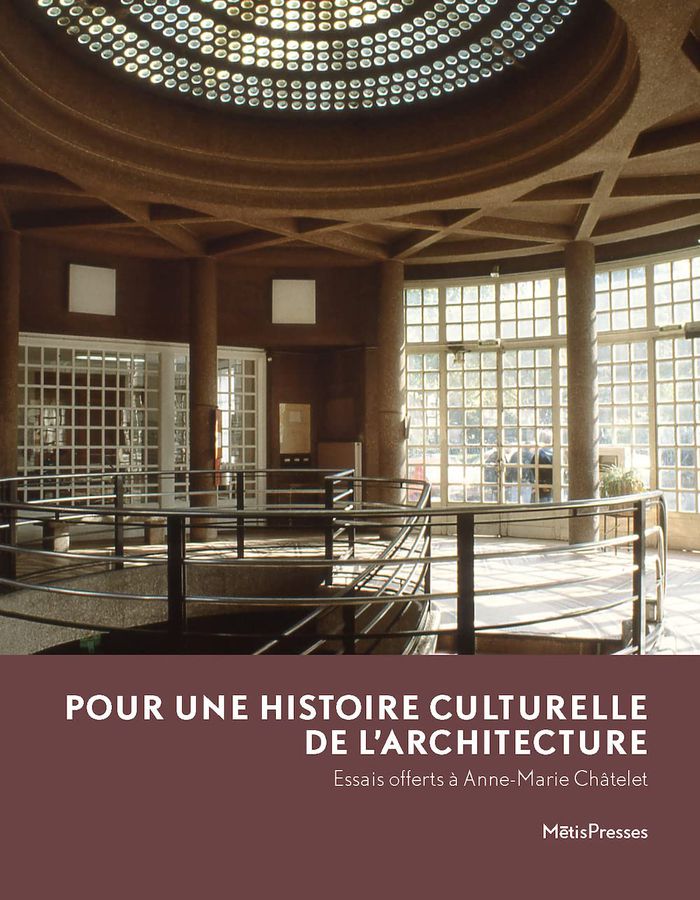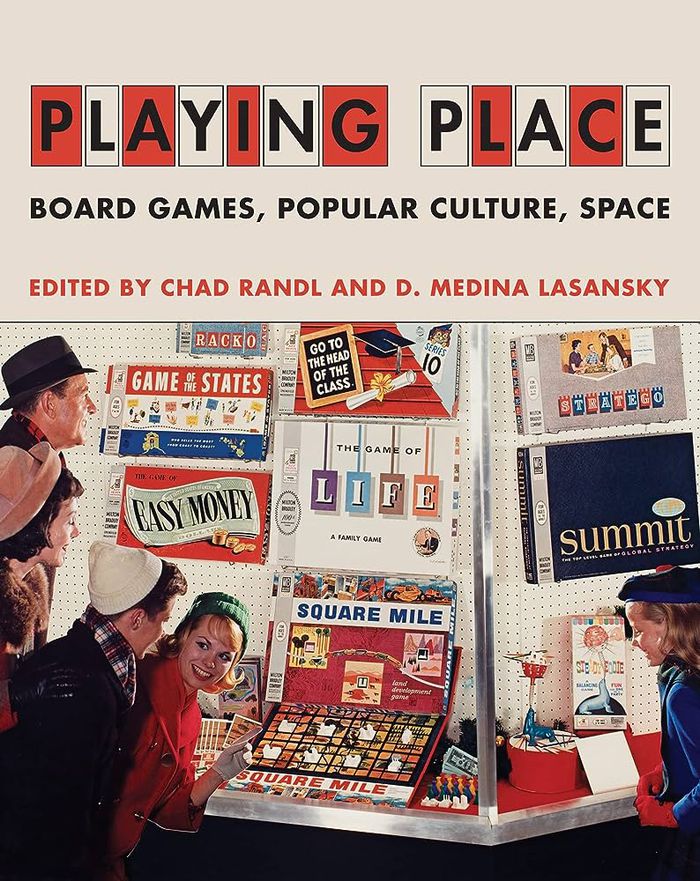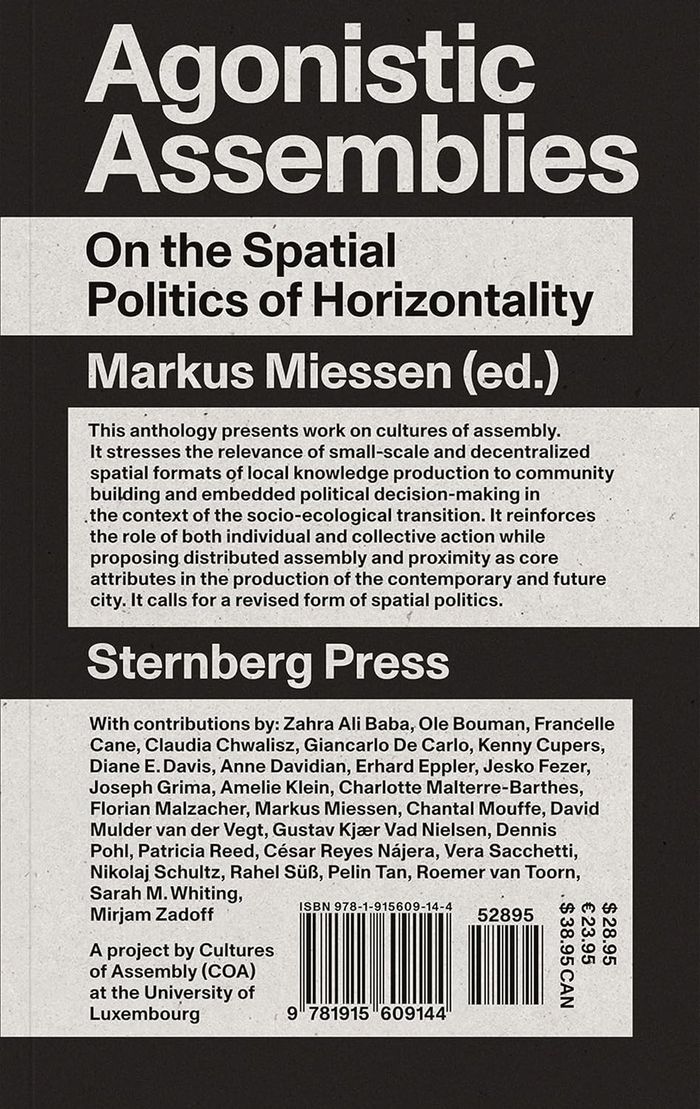$60.95
(disponible sur commande)
Résumé:
Cet ouvrage collectif est conçu en hommage à Anne-Marie Châtelet – anciennement professeure d’histoire et de culture architecturales et présidente de la Commission de la recherche et de la pédagogie à l’École nationale supérieure d’architecture de Strasbourg –, qui a fortement défendu, pendant son parcours de chercheure et d’enseignante dans les écoles d’architecture, la(...)
Pour une histoire culturelle de l'architecture : essais offerts à Anne-Marie Châtelet
Actions:
Prix:
$60.95
(disponible sur commande)
Résumé:
Cet ouvrage collectif est conçu en hommage à Anne-Marie Châtelet – anciennement professeure d’histoire et de culture architecturales et présidente de la Commission de la recherche et de la pédagogie à l’École nationale supérieure d’architecture de Strasbourg –, qui a fortement défendu, pendant son parcours de chercheure et d’enseignante dans les écoles d’architecture, la place du champ historique et ainsi contribué à développer et à enrichir la recherche en histoire de l’architecture.Sont rassemblés ici près de 40 contributions signées par ses condisciples, actuels ou anciens collègues, vieux amis et jeunes doctorants, étudiants d’antan et collaborateurs d’aujourd’hui. Elles font écho aux principaux thèmes de recherche chers à Anne-Marie Châtelet :- Un premier axe regroupe des textes centrés sur l’histoire d’édifices bâtis aux 19e et 20e siècles en Europe, analysant ainsi l’architecture scolaire, religieuse mais aussi celle du logement ou d’équipements plus exceptionnels, par le biais de méthodes d’étude typo-morphologique.- Le deuxième aborde le milieu et la pratique des architectes, au fil du 20e siècle, moins dans une approche des individus que dans celle des bâtisseurs comme groupe professionnel, voire comme groupe social.- Le troisième axe éclaire des problématiques liées aux échanges, transferts et métissages dans les domaines architectural et urbain.
Théorie de l’architecture
$28.00
(disponible sur commande)
Résumé:
''Drawing Matter Extracts 2: Women writing architecture'' is edited by Helen Thomas and collects together 24 texts written by women in architectural practice and connected disciplines. The anthology is published to coincide with the launch of the Women Writing Architecture website (www. womenwritingarchitecture.org), an annotated bibliography of writing about(...)
Drawing Matter Extracts 2: Women writing architecture
Actions:
Prix:
$28.00
(disponible sur commande)
Résumé:
''Drawing Matter Extracts 2: Women writing architecture'' is edited by Helen Thomas and collects together 24 texts written by women in architectural practice and connected disciplines. The anthology is published to coincide with the launch of the Women Writing Architecture website (www. womenwritingarchitecture.org), an annotated bibliography of writing about architecture by women. ''Women writing architecture'' includes texts by Helen Thomas, Sheila O’Donnell, Stephanie Macdonald, Philippa Lewis, Caroline Voet, Iris Moon, Desley Luscombe, Zoe Zenghelis, Mari Lending, Maria Conen, Deanna Petherbridge, Marie-José van Hee, Roz Barr, Asli Çiçek, Ana Araujo, Sarah Handelman, Emma Letizia Jones, Anahat Chandra, Emily Priest, Angharad Davies, Deepiga Kameswaran and Emerald Liu.
Théorie de l’architecture
$47.95
(disponible en magasin)
Résumé:
The question of what heritage is and how we deal with it is not a neutral one. Recent events such as the Black Lives Matter movement and the toppling of monuments have made evident how much the colonial past is inscribed in our built environment; at the same time, colonialism affects memorialization and historiography. Hence, those involved in architectural history are(...)
Théorie de l’architecture
juin 2024
Architectures of colonialism: Constructed histories, conflicting memories
Actions:
Prix:
$47.95
(disponible en magasin)
Résumé:
The question of what heritage is and how we deal with it is not a neutral one. Recent events such as the Black Lives Matter movement and the toppling of monuments have made evident how much the colonial past is inscribed in our built environment; at the same time, colonialism affects memorialization and historiography. Hence, those involved in architectural history are challenged to re-consider their positionality. Whose heritage are colonial sites? Which conflicting memories are attached to them? How are archives and material evidence reassessed to bring forward the stories of marginalized subjects? Following the call for decolonization, this volume explores historical methodologies and shows the entanglement of narratives at architectural sites, bringing together archaeology, architectural history, and heritage studies.
Théorie de l’architecture
$53.95
(disponible sur commande)
Résumé:
''Amaza Lee Meredith imagines herself modern'' tells the captivating story of Amaza Lee Meredith, a Black woman architect, artist, and educator born into the Jim Crow South, whose bold choices in both life and architecture expand our understanding of the Great Migration and the Harlem Renaissance, while revealing the importance of architecture as a force in Black(...)
Amaza Lee Meredith imagines herself modern: Architecture and the Black Amercian middle class
Actions:
Prix:
$53.95
(disponible sur commande)
Résumé:
''Amaza Lee Meredith imagines herself modern'' tells the captivating story of Amaza Lee Meredith, a Black woman architect, artist, and educator born into the Jim Crow South, whose bold choices in both life and architecture expand our understanding of the Great Migration and the Harlem Renaissance, while revealing the importance of architecture as a force in Black middle-class identity. Through her charismatic protagonist, Jacqueline Taylor derives new insights into the experiences of Black women at the forefront of culture in early twentieth-century America, caught between expectation and ambition, responsibility and desire. Central to Taylor’s argument is that Meredith’s response to modern architecture and art, like those of other Black cultural producers, was not marginal to the modernist project; instead, her work reveals the tensions and inconsistencies in how American modernism has been defined. In this way, the book shines a necessary light on modernism’s complexity, while overturning perceived notions of race and gender in relation to the modernist project and challenging the notion of the white male hero of modern architecture.
Théorie de l’architecture
$53.95
(disponible sur commande)
Résumé:
An essay collection exploring the board game's relationship to the built environment, revealing the unexpected ways that play reflects perceptions of space. Although board games are often recreational objects, their mythologies and infrastructure do not exist in a vacuum—rather, they echo and reproduce prevalent cultural landscapes. This thesis forms the throughline of(...)
Playing place: Board games, popular culture, space
Actions:
Prix:
$53.95
(disponible sur commande)
Résumé:
An essay collection exploring the board game's relationship to the built environment, revealing the unexpected ways that play reflects perceptions of space. Although board games are often recreational objects, their mythologies and infrastructure do not exist in a vacuum—rather, they echo and reproduce prevalent cultural landscapes. This thesis forms the throughline of pieces reflecting on subjects as diverse as the rigidly gendered fantasies of classic mass-market games; the imperial convictions embedded in games that position player-protagonists as conquerors establishing dominion over their “discoveries”; and even the uncanny prescience of games that have players responding to a global pandemic. Representing a thrilling convergence of historiography, architectural history, and media studies scholarship, Playing Place suggests not only that tabletop games should be taken seriously but also that the medium itself is uniquely capable of facilitating our critical consideration of structures that are often taken for granted.
Théorie de l’architecture
$59.95
(disponible en magasin)
Résumé:
Lurking under the surface of our modern world lies an unseen architecture—or anarchitecture. It is a possible architecture, an analogous architecture, an architecture of anarchy, which haunts in the form of monsters that are humans and machines and cities all at once; or takes the form of explosions, veils, queer, playful spaces, or visions from artwork and video games.(...)
The monster Leviathan: Anarchitecture
Actions:
Prix:
$59.95
(disponible en magasin)
Résumé:
Lurking under the surface of our modern world lies an unseen architecture—or anarchitecture. It is a possible architecture, an analogous architecture, an architecture of anarchy, which haunts in the form of monsters that are humans and machines and cities all at once; or takes the form of explosions, veils, queer, playful spaces, or visions from artwork and video games. In The Monster Leviathan, Aaron Betsky traces anarchitecture through texts, design, and art of the twentieth and early twenty-first century, and suggests that these ephemeral evocations are concrete proposals in and of themselves. Neither working models nor suggestions for new forms, they are scenes just believable enough to convince us they exist, or just fantastical enough to open our eyes.
Théorie de l’architecture
$41.00
(disponible sur commande)
Résumé:
In ''The City in the City'', Amy Thomas offers the first in-depth architectural and urban history of London's financial district, the City of London, from the period of rebuilding after World War II to the explosive climax of financial deregulation in the 1980s and its long aftermath. Thomas examines abstract financial ideas, political ideology, and invisible markets as(...)
The city in the city: Architecture and change in London's Financial District
Actions:
Prix:
$41.00
(disponible sur commande)
Résumé:
In ''The City in the City'', Amy Thomas offers the first in-depth architectural and urban history of London's financial district, the City of London, from the period of rebuilding after World War II to the explosive climax of financial deregulation in the 1980s and its long aftermath. Thomas examines abstract financial ideas, political ideology, and invisible markets as concrete realities; working on four spatial scales—city, street, facade, and interior—the book explores the grand plans, hidden alleys, neo-Georgian elevations, and sweaty dealing floors that have made the financial center work.
Théorie de l’architecture
$28.95
(disponible en magasin)
Résumé:
In this volume of the Critical Spatial Practice series, Dennis Pohl locates the origin of Europe's dependency on carbon and nuclear power in the postwar architectural designs and energy policies of the European Community. Since the 1950s, architects have proposed territorial, regional, and urban development plans that served the European political project. They(...)
Building carbon europe: Coal, steel and nuclear power. Critical spatial practice
Actions:
Prix:
$28.95
(disponible en magasin)
Résumé:
In this volume of the Critical Spatial Practice series, Dennis Pohl locates the origin of Europe's dependency on carbon and nuclear power in the postwar architectural designs and energy policies of the European Community. Since the 1950s, architects have proposed territorial, regional, and urban development plans that served the European political project. They collaborated with the European Coal and Steel Community in an effort to render the steel building industry as efficient as the car industry; they incorporated the ideas of infinite nuclear energy, as promoted by the European Atomic Energy Community, into their designs. This book demonstrates how architecture served the political economy of postwar Europe as a means of turning coal, steel, and radioactivity into tools of European governance. Architectural design enabled EU institutions to support social policies and worker housing within the coal and steel industry as well as to promote a new pan-European lifestyle based on nuclear energy. In other words, architecture powered Europe's larger infrastructural, economic, and cultural network. Pohl's work not only sheds light on how architecture has contributed to the carbonization of Europe, it also highlights the environmental issue, which challenges both architectural criticism and historiography in the era of the Anthropocene.
Théorie de l’architecture
$38.95
(disponible en magasin)
Résumé:
This anthology presents work on cultures of assembly. It stresses the relevance of small-scale and decentralized spatial formats of local knowledge production to community building and embedded political decision-making in the context of the socio-ecological transition. It reinforces the role of both individual and collective action while proposing distributed assembly(...)
Agonistic assemblies: On the spatial politics of horizontality
Actions:
Prix:
$38.95
(disponible en magasin)
Résumé:
This anthology presents work on cultures of assembly. It stresses the relevance of small-scale and decentralized spatial formats of local knowledge production to community building and embedded political decision-making in the context of the socio-ecological transition. It reinforces the role of both individual and collective action while proposing distributed assembly and proximity as core attributes in the production of the contemporary and future city. It calls for a revised form of spatial politics. "Agonistic assemblies" asks: how can spaces—both physical and virtual—be envisaged to create publics? How is collectivity and society being generated spatially and in terms of policy? How do we “practice” society as a bodily, spatial form, and how does this practice contribute to spatial justice? Are there specific spatial settings that can intensify these practices? What kind of spatial design can we imagine as platforms for change?
Théorie de l’architecture
$25.95
(disponible en magasin)
Résumé:
An ever-increasing proportion of our lives is spent in supermarkets, airports and hotels, on motorways or in front of TVs, computer and cash machines. This invasion of the world by what Marc Auge calls 'non-space' results in a profound alteration of awareness: something we perceive, but only in a partial and incoherent manner. Auge uses the concept of 'supermodernity' to(...)
Non-places: An introduction to supermodernity
Actions:
Prix:
$25.95
(disponible en magasin)
Résumé:
An ever-increasing proportion of our lives is spent in supermarkets, airports and hotels, on motorways or in front of TVs, computer and cash machines. This invasion of the world by what Marc Auge calls 'non-space' results in a profound alteration of awareness: something we perceive, but only in a partial and incoherent manner. Auge uses the concept of 'supermodernity' to describe the logic of these late-capitalist phenomena - a logic of excessive information and excessive space. In this fascinating and lucid essay he seeks to establish and intellectual armature for an anthropology of supermodernity. Starting with an attempt to disentangle anthropology from history, Auge goes on to map the distinction between place, encrusted with historical monuments and creative social life, and non-place, to which individuals are connected in a uniform manner and where no organic social life is possible.
Théorie de l’architecture









